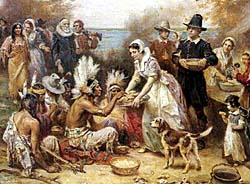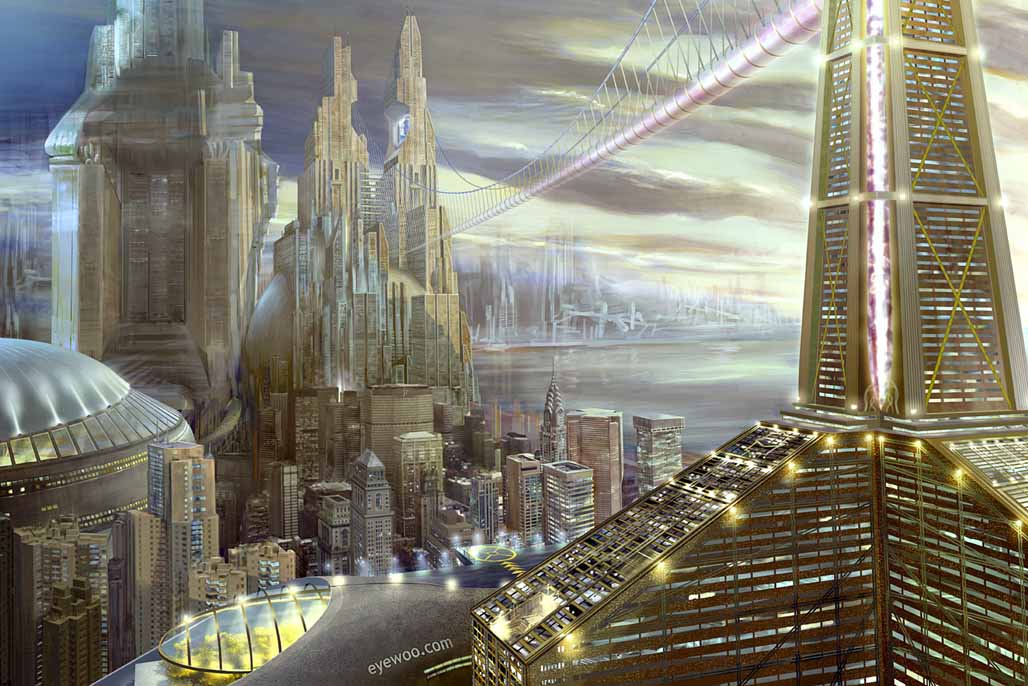 |
|
Utopian Fiction & Experimental Communities in North America / USA |
 "The First Thanksgiving" |
Pre-Columbian North American Indian culture as romanticized ecotopia? (Speech by Chief Seattle & "Messiah Letter" of Wovoka)
Biblical Utopias: Garden of Eden (Genesis), Heaven (Revelation), Apostolic Community (Acts 2.42-45)
Classical Greek utopias: Plato’s Republic; Plotinus, Platonopolis
Renaissance Europe: Thomas More, Utopia (1516); Tomaso Campanella, The City of the Sun (1602); Francis Bacon, The New Atlantis (1623)
Early European-America:
Communities: New England founded as state with Christian-based communitarian principles. "Pilgrims" at Plymouth attempt commonwealth resembling Plato's Republic. John Eliot, "Apostle to the Indians," organizes Indian "Praying Towns" on utopian principles based on Old Testament.
Texts: William Bradford, Of Plymouth Plantation (1600s); John Winthrop, "A Model of Christian Charity" (1630); John Eliot, Indian Tracts
(see Utopian Texts from "Founding Texts" of European America + Adam Smith's The Wealth of Nations)
![]()
Revolution-era USA (1770s-1890s):
American Revolution is widely regarded as a "conservative revolution" where the top layer of political heirarchy was removed but property rights (including slaves) were preserved.
![]()
Antebellum USA (1830s-50s): peak period for intentional communities, partly because of Financial Panic of 1837, partly b/c of growth of millennial religion in early-19c Second Great Awakening:
Communities: Shakers, Mormons, Oneida, Brook Farm (Transcendentalist-Fourierist), Fruitlands (Alcott family); dystopias: slave plantations
Texts: Nathaniel Hawthorne's 1852 novel The Blithedale Romance is set at a fictional version of Brook Farm, of which Hawthorne was briefly a member;
Louisa May Alcott, "Transcendental Wild Oats
James Fenimore Cooper, The Crater (1847)
[see 19th-century utopias]
![]()
Progressive Era (1890s-1910s): reaction against libertarian Gilded Age, growing inequality, plutocracy.
Utopian novels: Edward Bellamy, Looking Backward, 2000-1887 (1887), William Dean Howells, Altruria Trilogy: A Traveler from Altruria (1891-2), Letters from Altruria (1904), Through the Eye of the Needle (1907); J. Frank Baum, The Wonderful Wizard of Oz (1900); C. P. Gilman, Herland (1915); also utopian novels from England, e.g. Samuel Butler, Erewhon (1872), William Morris, News from Nowhere (1890)
Dystopian novels: Negative responses and sequels to Looking Backward
Communities: community of Altruria, based on Howells' utopian trilogy below, briefly established in California in 1894.
![]()
New Deal / Cold War (1930s-1950s): growth of Social Democracies or Democratic Socialism (social safety net, growth of middle-class, reduction of poverty and restraints on wealth, etc.)
Communities: various socialist communes, + unions & government-supported conservation and arts (CCC & WPA); Israeli kibbutzim
Dystopian novels: Aldous Huxley, Brave New World (1931); Ayn Rand, Anthem (1938); George Orwell, Animal Farm (1945) and Nineteen Eighty-Four (1948); William Golding, Lord of the Flies (1954)
Utopian novels: B.F. Skinner, Walden Two (1948); Aldoux Huxley, Island (1962)
(Huxley, Orwell, & Golding are British authors, but texts mentioned feature strongly in American school curricula and popular culture)
![]()
1960s-70s: social reform (civil rights) and protest (Vietnam); sexual revolution; mind alteration; Human Potential Movement; campus unrest; Great Society expansion of New Deal w/ Medicare, Medicaid, Headstart, etc.; Movement Conservatism reacts by creating corporate-supported counter-institutions.
Communities: Twin Oaks, Los Horcones, numerous hippie communes
Utopian novels: (most of these texts are too long for summer school)
Ursula
K. LeGuin, The Dispossessed: An Ambiguous
Utopia (1974); Always Coming Home (1985)
Ernest Callenbach, Ecotopia (1975); Ecotopia Emerging (1981)
Marge
Piercy, Woman on the Edge of Time
(1976)
![]()
1980s- : "Neoliberalism": deregulated free market; privatization of government services; trade barriers and unions dismantled, lower taxation on wealth, limited government; corporations abandon responsibility for employees and communities in favor of shareholder profits; financial industry grows; USA turns from "rich country" to "country that makes rich people richer"; increasing inequality; repeated "crashes" of financial institutions followed by government bailouts; "new normal" of high unemployment and government / consumer debt; impending environmental catastrophes from overpopulation, overdevelopment & resource depletion, global warming, mutant viruses.
Communities: 60s-70s communes including kibbutzim adapt to neoliberalism with eco-tourism, retreats, organic products and handicrafts.
Utopian & dystopian fiction appears partially in texts including Toni Morrison, Paradise (1996); Neal Stephenson, Snow Crash (1992); Margaret Atwood, Maddaddam Trilogy: Oryx and Crake (2004), The Year of the Flood (2009), Maddaddam (2013).
Dystopian fiction: Margaret Atwood, The Handmaid's Tale (1985); Octavia Butler, Parable of the Sower (1993), Parable of the Talents (1998).
Cold-War Dystopias continue to be taught in American high school curricula.
Young Adult Dystopias (usu. as series) become publishing phenomenon; e.g., Suzanne Collins, The Hunger Games (2008); Lois Lowry, The Giver (1993); Scott Westerfield, Uglies (2005); various post-apocalyptic zombie / vampire dystopias, graphic novels, and films.
